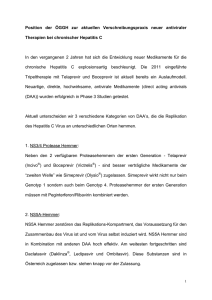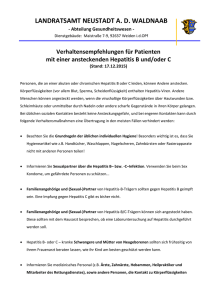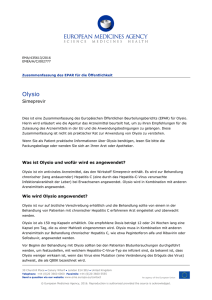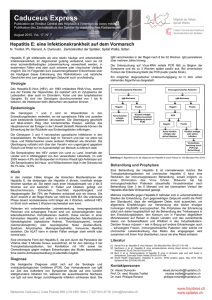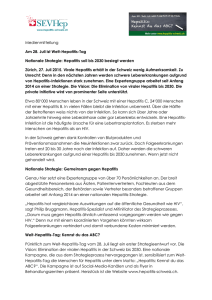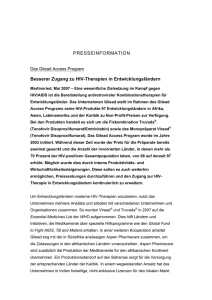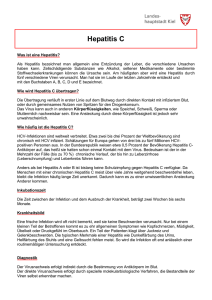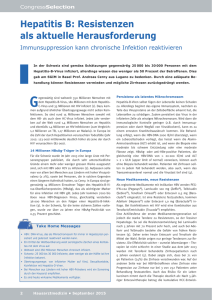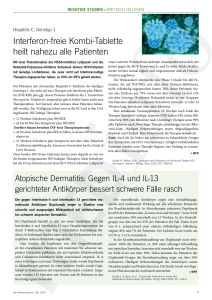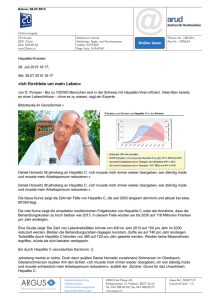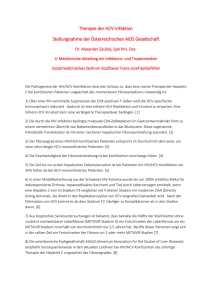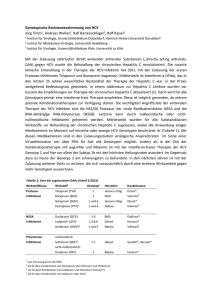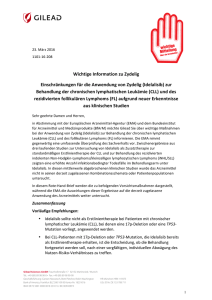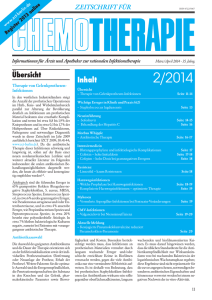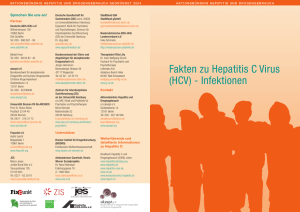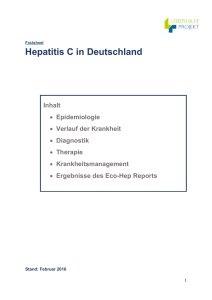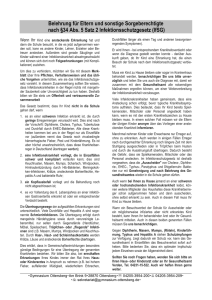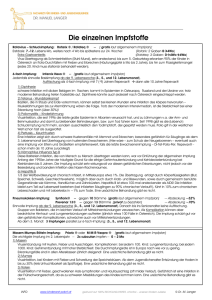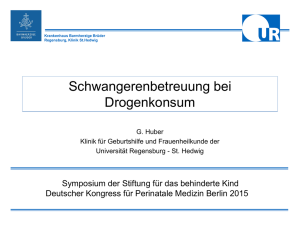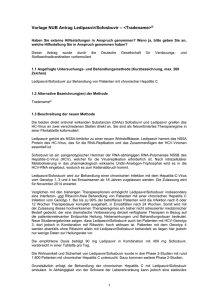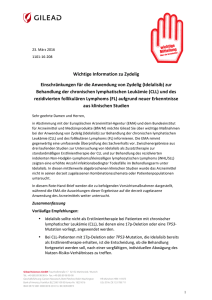PowerPoint Präsentation Hepatitis C-Medikation
Werbung
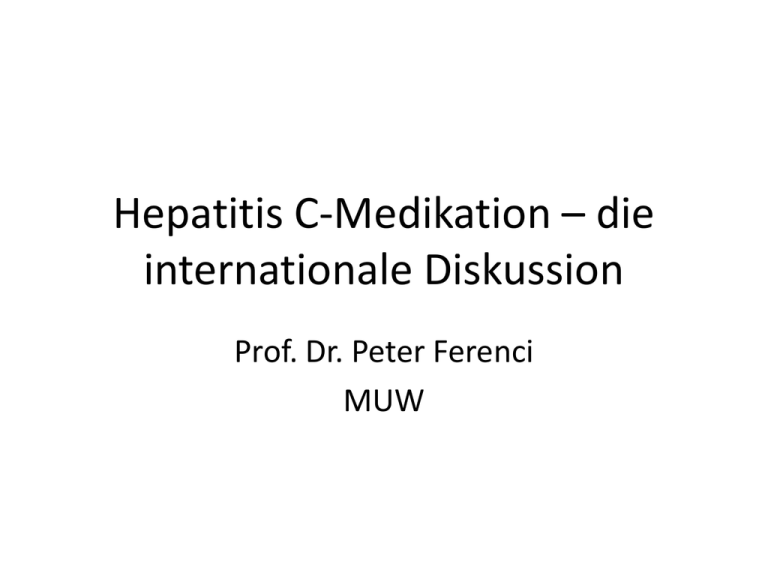
Hepatitis C-Medikation – die internationale Diskussion Prof. Dr. Peter Ferenci MUW Hepatitis C • Eine durch Blut/Blutprodukte übertragene chronische Viruserkrankung • Weltweit etwa 120 Millionen Menschen betroffen, in Ö ca. 30000-60000 • Führt zu Zirrhose, Leberkrebs und erhöhter Mortalität • In der westlichen Welt Grund für 1/3 der Lebertransplantationen Therapie bis 2013 Medikament Effektivität Therapiedauer Zirrhose behandelbar Interferon 5% 6-12 Monate nein Interferon/Ribavirin 35% 12 Monate nein PegInterferon/Ribavirin 45-50 6-18 Monate nein PegInterferon/Ribavirin+ Proteasehemmer* 63-75% 24-48 Wochen nein * Telaprevir, Boceprevir seit 2011 • Bessere Therapien dringend notwendig Polymerasehemmer Probleme • 1993 Fialuridine – Leberversagen (einige Todesfälle) • ~2000 Valocitabine – GI Probleme, Entwicklung beendet • 2010 Mericitabine - hohe Relapserate • 2013 IDX 184 - Kardiotoxisch • 1998 Pharmasset wird gegründet (R. Schinazi, Emory Universität, Atlanta), Focus – Entwicklung antiviraler Medikamente • 2008 Roche lizenziert Mericitabine von Pharmasset zur Therapie der Hepatitis C, Vorkaufsrecht für PSI-7977 (Sofosbuvir) für 500 Millionen U$ • 2011 E. Gane (Auckland) präsentiert erste klinische Daten mit Sofusbuvir beim US Leberkongress • 4 Tage später kauft Gilead Pharmasset um 11,2 Milliarden U$ • 2013: FDA genehmigt Sofosbuvir zur Therapie der Hepatitis C Die 1000$ Pille - Sofosbuvir MUSS IN KOMBINATION MIT ANDEREN MEDIKAMENTEN GEGEBEN WERDEN Ein 12 Wochen Therapiezyklus U$ 84000.- + 2. Medikament Study Type of Geno N pretreatment type Heilungsraten (%) ION 1 naive 1a+1b 718 100 12 weeks + RBV 100 ION 2 experienced 1a+1b 352 95 100 ION 3 naive 1a+1b 647 ION 4 HIV/HCV 1a+1b 268 1a 322 95.3 1b 151 98.0 1a 173 96.0 1b 123 96.7 Sapphire 1 naive Sapphire 2 experienced 8 weeks 94 8 weeks +RBV 93.1 12 weeks 95.4 96.6 Pearl 1 naive 4 135 90.9 100 Pearl 2 experienced 1b 179 100 96.6 Pearl 3 naive 1b 419 99.0 99.5 Pearl 4 naive 1a 305 90.2 97.0 ALLY II naïve + HIV 1a/1b experienced 1a/1b 91/1 83.3/50 8 20/8 naive 3a 101 90 51 86 1a 157 92 1b 131 99 ALLY III experienced GRZ/ELB naive 96.7/100 100/100 24 weeks 99.5 24 weeks+ RBV 100 99 99 Die Pharmaindustrie DIE HEPATITIS C IST BESIEGT! Die Verschiebung des Schwerpunktes von Patienten zum Aktionär Methoden • Evidence (?) Based Medicine (EBM) – Pharmaindustrie sponsert Phase 3 Studien (Grundlage für Zulassung) – Top Journale publizieren gerne Phase 3 Studien (warum? Was bekommen sie dafür?) – Unabhängige Überprüfung scheitert an den Kosten – “Guidelines” durch wissenschaftliche Gesellschaften basieren auf Phase 3 aber auch Phase 2 Studien • Kostenanalysen – Entbehren jeder vernünftigen Grundlage. Was ist ein Menschenleben wert? Was ist eine nebenwirkungsfreie Therapie wert? Specialty Society Clinical Practice Guidelines (CPGs) Time for Evolution or Revolution?* • The IOM (Institute of Medicine) has strongly suggested that the current approach to development of CPGs is flawed and fundamentally needs a new approach (*Classen DC, JAMA 2015;314:278) • Of 45 CPGs from 14 specialty societies revealed that conflicts of interests (COIs) among panel members were common, but reporting of these members’ COI disclosures was not (Bindslev JB, et al, BMC Med Ethics. 2013;14:19.) • EBM? oder • Shared holder generated evidence based medicine? Preisgestaltung • Wird von Marktanalysten vorgeschlagen, hat mit den wahren Kosten der Entwicklung, Produktion und Vertrieb nichts zu tun! Hill et al, CID 2014 Kosten für eine Behandlung van de Veen et al, Hepatology 2015 We can therefore estimate that private investors spent perhaps $300 million in R&D outlays for sofosbuvir over the course of a decade, and perhaps well below that sum. Those R&D outlays were likely recouped in a few weeks of sales in 2014. With a rational U.S. drug pricing system, private investors would expect to earn a reasonable multiple of their R&D for a highly successful drug, perhaps even 5 to 10 times the R&D outlays, in order to reflect the long time horizons and high uncertainties surrounding drug development. Yet at a treatment course of $84,000, the multiple for Sovaldi looks to be around 40 times or more. With a rational drug pricing system, Gilead might have paid $1 billion rather than $11.2 billion for the drug, and Prof. Schinazi might have pocketed $40 million rather than $440 million. Sovaldi would most likely still have been developed and brought to market on the same timeline, but with taxpayers spared of perhaps $10 billion a year in outlays. J. Sachs, Huffington Post 2015 Gilead Sciences sold $10.3 billion of its new hepatitis C drug Sovaldi in 2014, a figure that brought it close to being the best-selling drug in the world in only its first year on the market • Nach der Formel von J. Sachs dürften 12 Wochen Sofosbuvir US$ 2000.- Kosten • In Indien kostet es US$ 300.- und Gilead bekommt davon noch Lizenzgebühren • ABER DAS IST POLITIK UND HAT MIT MEDIZIN NICHTS ZU TUN Three tier pricing Hersteller Reiche Länder zahlen Toppreise ? mittelreiche Länder zB. Ost EU arme Länder Unterstützung Tiered Pricing • Three basic tiered pricing bands that serve as the starting point for negotiations with national governments • Countries are categorized within the bands according to gross national income (GNI) per capita (a reflection of the average income of a country’s citizens) and hepatitis C prevalence. - The tiers follow World Bank nomenclature of (i) Low-income; (ii) Lower-middle-income; (iii) Upper-middle-income - Gilead classifies more countries as low- and lower-middle-income than the World Bank does - As disease prevalence is considered, some countries classified as lower-middle-income by the World Bank are included in Gilead’s lowest tier • Final prices are determined on a country-by-country basis Indian Generic Licensees • • • • • • • Cadila Healthcare Ltd Cipla Ltd Hetero Labs Ltd Mylan Laboratories Ltd Ranbaxy Laboratories Ltd Strides Arcolab Ltd Sequent Scientific Ltd More than 100 million people living with hepatitis C • 91 countries included • 54% of the estimated HCV infected global population • 75% of countries designated low-middle Income • 90% of people living in low-middle income countries Ein e-mail aus Indien • We would like to inform you that your patients can access generic Sofosbuvir manufactured in India under license from Gilead for export to various developed countries. This would cost them USD 320 / unit (pack of 28 Tabs) compared to exorbitant price that your patient may need to pay in other countries. • Against prescription these drugs can be shipped to your patients. • Sofosbuvir is therefore becoming a test of big pharma’s ability to sell drugs at widely divergent prices in different parts of the world. It comes at a time when the industry is attempting to defend hefty profit margins in rich countries while providing affordable access to treatments in the developing world. (pharmaceuticals 4/2015) Wer zahlt wem? • Kostenübernahme durch Versicherungen in EU Staaten – Deutschland, Frankreich (alle Fibrosegrade), Österreich (F2-4), Niederlande, Schweden, UK (F3-4) – Spezielle Arrangements in Italien, Polen, Portugal • Einschränkung auf fortgeschrittene Lebererkrankungen + Lebertransplantierte (medizinisch durchaus begründbar) Problem für Sozialversicherungen • Der hohe Preis fällt auf einmal an, aber keine Folgekosten! Belastung des Jahresbudgets, aber signifikante Einsparung nach 10 Jahren • Bei HIV und bei Hepatitis B Jahreskosten geringer, aber lebenslange Therapie notwendig! (Kosten bis zu € 500000.-!) In Österreich purzeln die Preise • Harvoni ca. € 31000.-/Therapie • Viekirax/Exviera ca. € 25000.-/Therapie (nicht der offizielle Preis) “…..the silent epidemic……” “…..the killer virus……..” Und viele andere Informationen (?) im Internet……. Sie sind Patient Arzt/Ärztin sagt Ihnen: Sie haben genug Zeit, um behandelt zu werden Was denken Sie über Ihren Arzt? Das war erst der Anfang • Repatha* (evolocumab), which is sponsored by Amgen, and Praluent* (alirocumab), which is sponsored by Sanofi and Regeneron—suggest, but do not definitively establish, that PCSK9 inhibitors will reduce not just LDL levels, but also a patient’s chance of a major cardiovascular “event”, like a heart attack or stroke. (*NEJM 2015) • Kostenpunkt: $14000.-/Jahr lebenslang - Kosten pro Jahr in den USA: 100 Milliarden U$ Pharma – Big business Medikament* US $/Tablette 2013 US $/Tablette 2015 % Anstieg Doxicycline 0,04 3,7 8281 Albuterol 0,11 4,34 4014 Digoxin 0,11 1,10 884 Valproat 0,39 2,93 736 Pravastatin 0,05 0,39 573 Turing Pharmaceuticals: DARAPRIME: This 62year-old drug just got 5,000% more expensive * Patente seit Jahren abgelaufen! Quelle: Times, Oct 5,2015 Lösungsvorschläge • Offenlegung der Entwicklungskosten bei der Einreichung bei FDA/EMA • Berechnung des Preises an Hand der realen Entwicklungskosten, sonst keine Kostenübernahme durch Versicherungen • Verpflichtende “head to head” Studien nach Zulassung • Verpflichtende Phase 4 Studien Sticker Shock and the Price of New Therapies for Hepatitis C: Is it worth it? It is easy to see how this will be a financial burden on our health care system. But if these individuals fail to be linked to a provider willing to administer HCV therapy, or if HCV therapy is out of reach due to barriers such as cost, the potential health care burden in the long run is even higher. Thus, although DAA therapy may be $1000 a pill, SVR is arguably priceless. Reau N and Jensen D, Hepatology 2014
